Windows Server – What’s New and What’s Next BRK1038
Hello all,
It's been a while since I've posted a new summary on the 2017 Ignite sessions, work is an all-encompassing thing.
As a reminder, Microsoft Ignite was held in Orlando, Florida from September 25th to the 29th 2017. Here are all the sessions for you to browse and watch at your convenience. The sessions are between 45 and 75 minutes each, and while I will be summarizing one of the sessions here, I definitely recommend watching the entire video, as every session has lots of great information. I'll be calling out key times in order to highlight specific wording or a demo – or something I want to call your attention to.
For the second installment, we are going to cover session BRK1038 – Windows Server What's New and What's Next. Please leave me comments, questions, and any session you would like to see covered!
This session is presented by Erin Chapple, General Manager Windows Server, and Chris Van Wesep, Director Product Marketing.
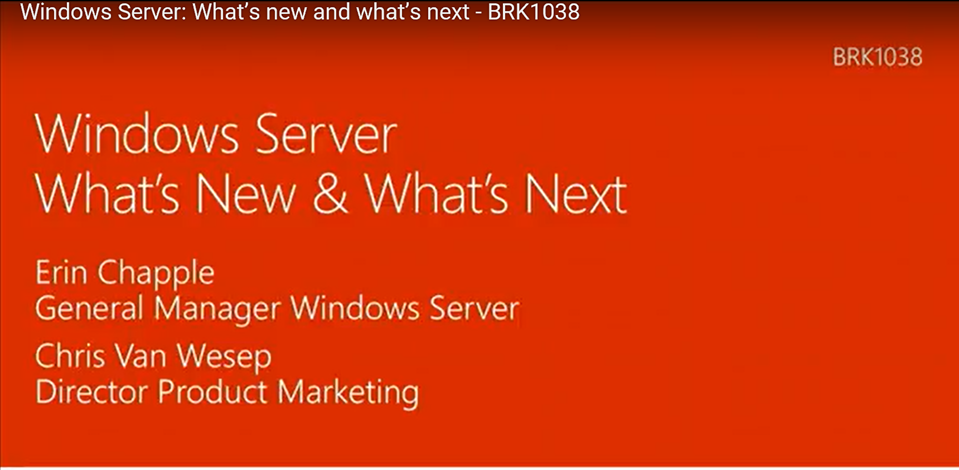
I started working on this blog post a while ago, before work took over and kept me way too busy, so some of the things mentioned here as 'coming soon' are already here now. That doesn't make the presentation and video any less relevant though. All the information is good, and it's also gathered here in one place for easy reference.
For me, it's also easier to grasp new concepts and technologies when I can hear someone explaining it as well as being able to read through the details. I feel like it's a richer learning experience that way, so if you can, be sure to check out the links to the video when you find the topics especially interesting.
First up we have a few Windows Server 2016 customer case studies:
- Rackspace and their Security
- a Government agency and their Storage experience
- biBERK and their application uses.
5:27 - Customer case studies - Security
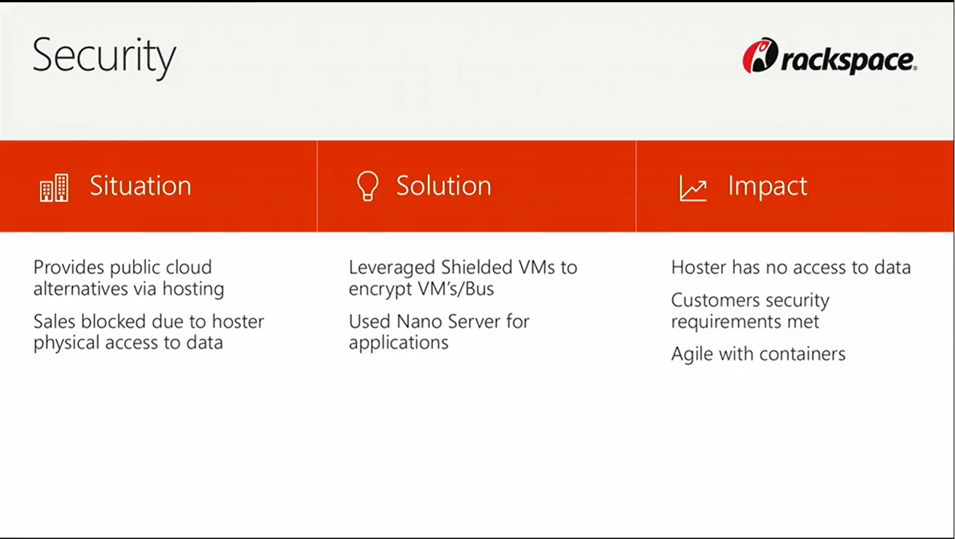 7:27 - Storage
7:27 - Storage
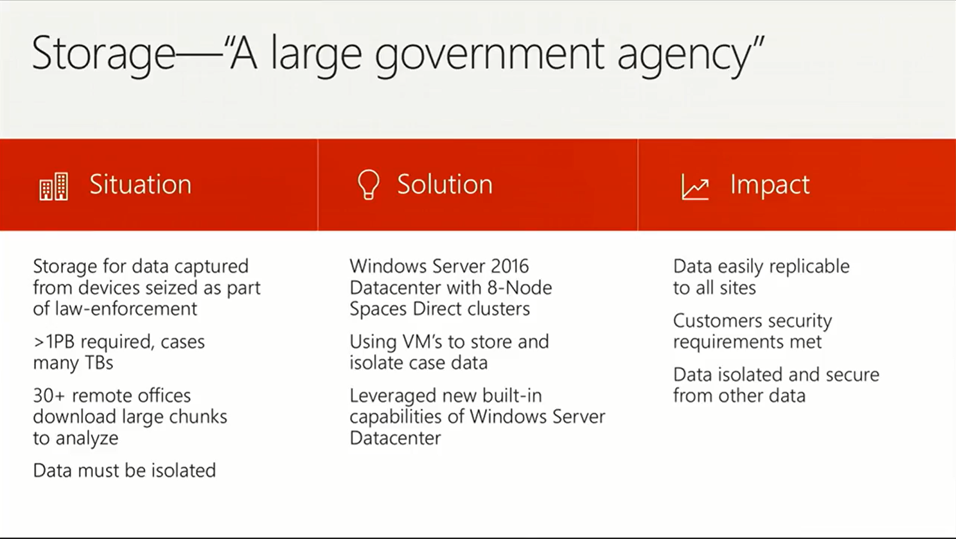 10:36 - Applications
10:36 - Applications
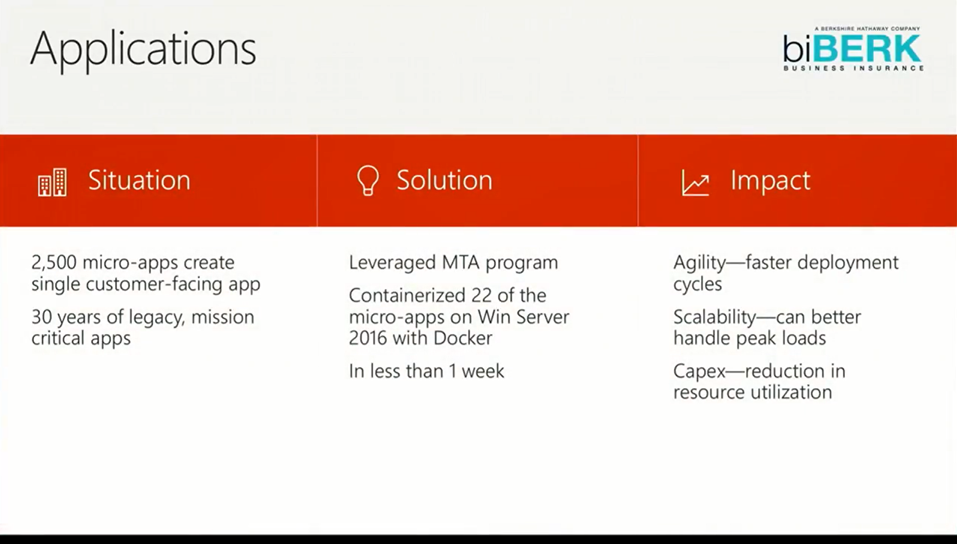 15:16 - Demo - Azure File Sync
15:16 - Demo - Azure File Sync
Here is the Azure File Sync announcement, where you can learn all about how the new Azure File Sync will allow you to extend your on-premises file servers into Azure. This is a great new feature which offers near real time syncing into Azure and allows for tiering of files between your on-premises systems and those in the cloud. Enabling this feature allows you to keep all your most frequently accessed files on local servers and those less frequently used files in the cloud. There are a great number of scenarios where Azure File Sync will be useful, including a potential replacement for Distributed File System (DFS), disaster recovery, and high availability.
19:39 - Release Cadence
Moving forward, Microsoft is changing the way in which they are releasing Windows Server updates and versions.
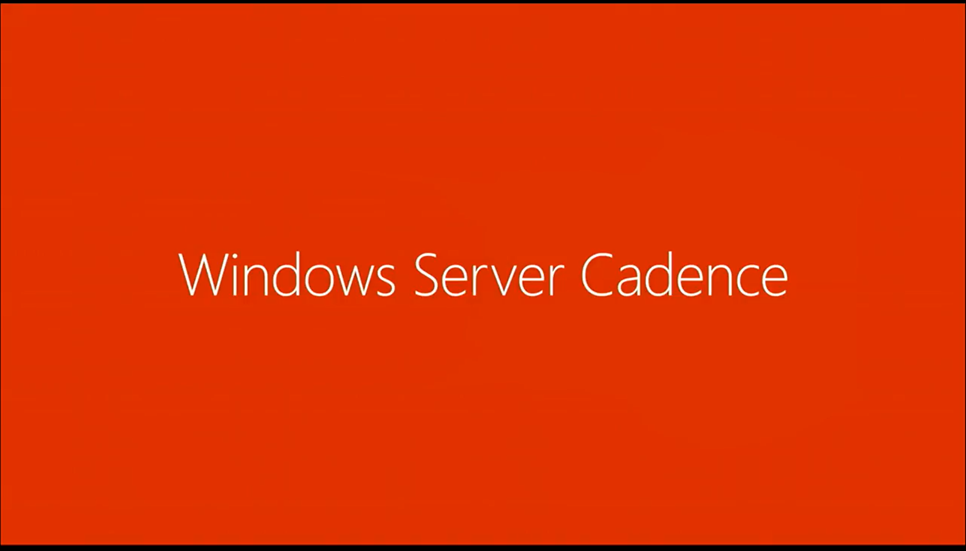
There will be two new "Channels" that Microsoft releases. The Semi Annual Channel (SAC), which releases twice a year, and the Long Term Servicing Channel (LTSC), which will release every 2-3 years.
The SAC releases are intended for fast moving development, with the latest and greatest technologies available. These releases will only have 18 months of mainstream support, and no extended support after that. That's an important detail to be aware of. Many companies take their time in applying updates and may even skip some patches. SAC releases won't support that way of thinking, you must stay up to date, at most two versions behind the most recent release. SAC releases are only available through Software Assurance (SA) or on Azure, and use the naming convention of Windows Server plus version, such as Windows Server 1709.
The LTSC releases are the releases that we - as tech people - are used to. Being released every 2-3 years, they will have 5 years of mainstream support and then another 5 years of extended support. These releases are available through all standard channels and follow the naming convention which we are accustomed to, Windows Server followed by the year of release, such as Windows Server 2016
This is not an either-or type of situation. Many companies are likely to have a mix of both types of Windows Servers, and it's important to understand the differences between the two.
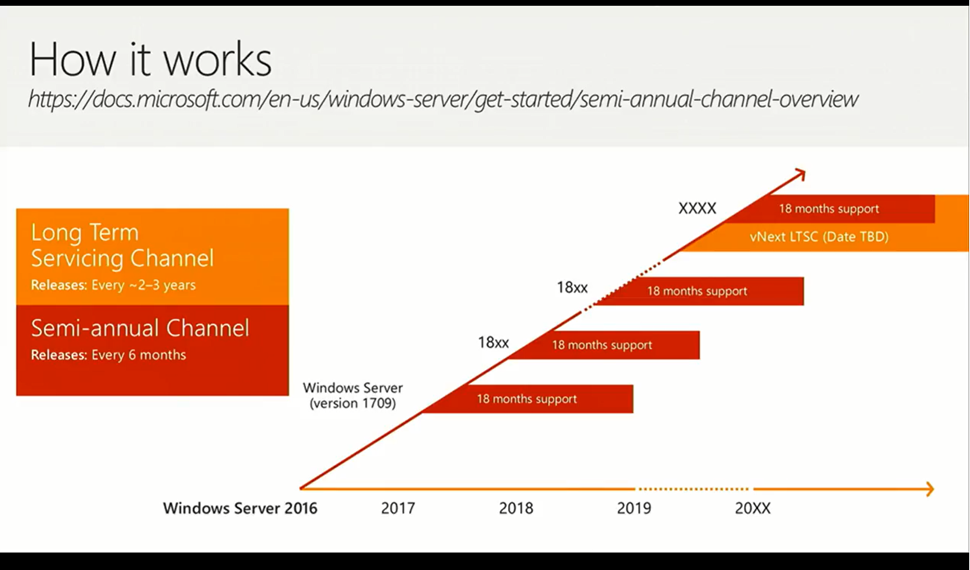 25:46 - Server Core is available in the SAC and the LTSC, and Nano Server is now only the base for containers and is no longer able to hold any infrastructure roles. The GUI is only available in the LTSC releases. This way you do not need to be concerned with the quick release cadence of the SAC while still getting the benefits of running Server Core. But if you really want that GUI experience, the SAC releases will not work for you.
25:46 - Server Core is available in the SAC and the LTSC, and Nano Server is now only the base for containers and is no longer able to hold any infrastructure roles. The GUI is only available in the LTSC releases. This way you do not need to be concerned with the quick release cadence of the SAC while still getting the benefits of running Server Core. But if you really want that GUI experience, the SAC releases will not work for you.
 29:00 - Fall release Windows Server 1709 - Hybrid application Platform, Modern Management
29:00 - Fall release Windows Server 1709 - Hybrid application Platform, Modern Management
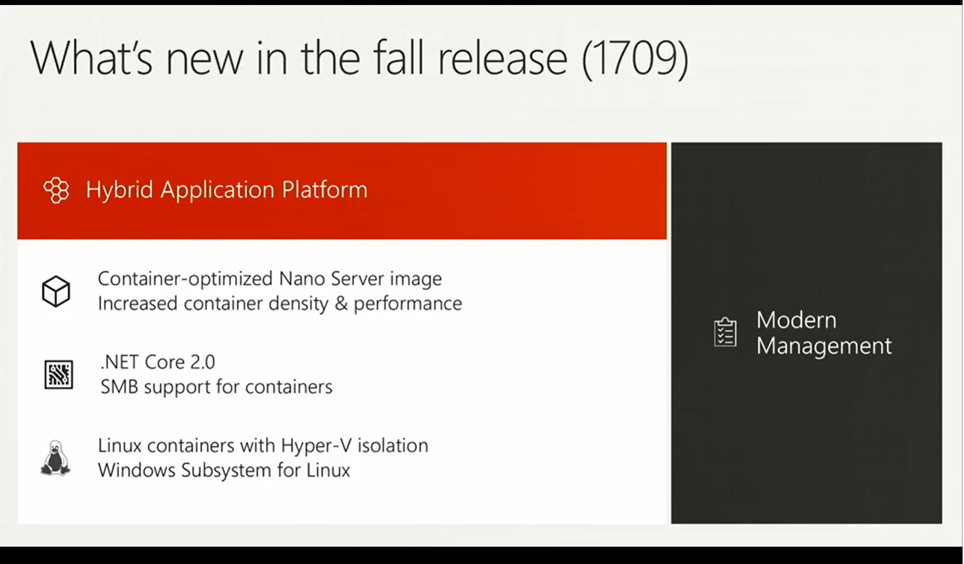
Windows Server 1709 is the first Windows Server available in the SAC and was released with the goal of increasing density, increasing performance, and allowing for the latest technology available at a fast pace. Containers are also a big part of this release, with some great new additions. SMB support has been enabled as well as Linux containers with Hyper-V isolation! This was a highly requested feature and we're happy to have it available. The Windows subsystem handles the hardware, but the container itself is pure Linux.
37:18 - Demo - Enabling Cloud apps with Nano Server & containers
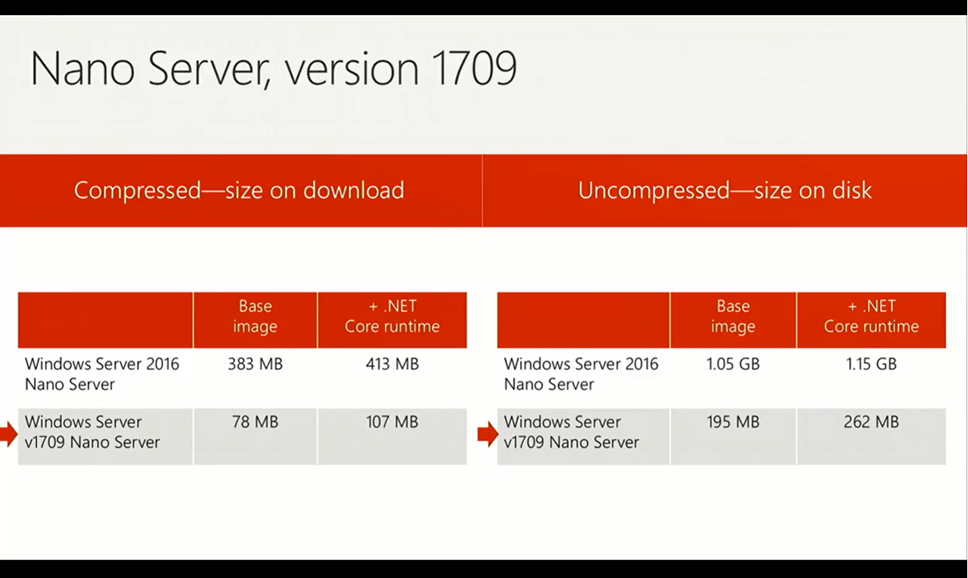
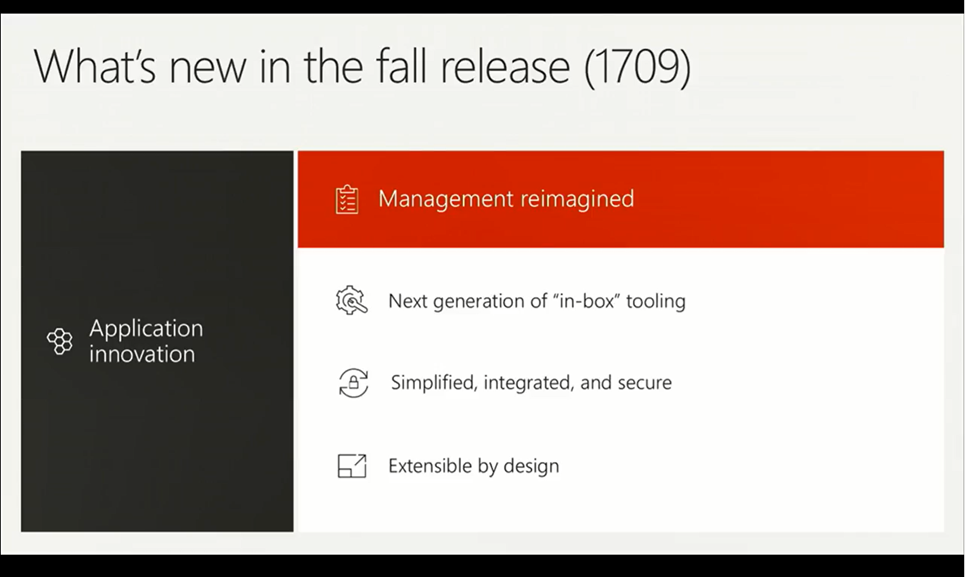 46:23 - Demo - Project Honolulu
46:23 - Demo - Project Honolulu
Here's one of those things that was not available at the time of Ignite but has since seen general availability. Project Honolulu is no longer called Project Honolulu, it is now the Windows Admin Center (WAC). The WAC is the new browser-based management tool that gives you full control of your server infrastructure. This new tool can replace most - if not all - of your existing MMC snap-in, and you can perform other functions with it. You can restart or shutdown systems, configure roles and features, and it's all agentless (one of the best features!). The WAC uses remote PowerShell and WMI over WinRM for easy use.
55:32 Software Assurance
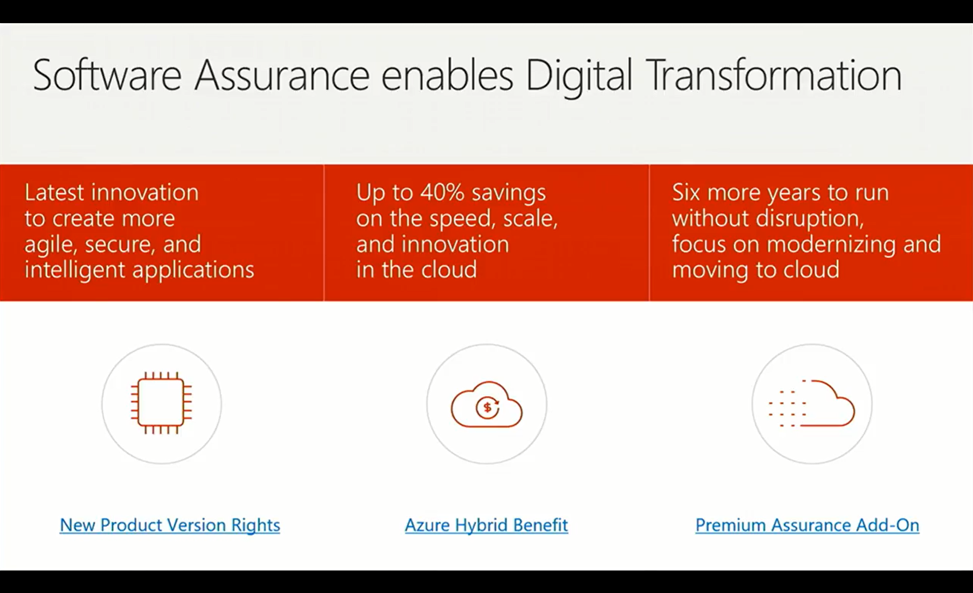
With Software Assurance (SA) you get rights to future products as they come out (ex 1709), and the same is true of semi-annual releases. The Azure Hybrid Benefit is the least expensive way to operate Windows server in the cloud as it gives you the right to run up to 2 VMS (up to 16 core) for each on-prem license.
There is a new level called Premium Assurance which gives time to focus on moving forward, adding 6 extra years of the product, so 5+5+6 instead of the standard 5+5. For those companies which struggle to retire old hardware and software, or need that extra time for upgrades and migrations, this is a huge benefit. For a small increase in the cost of licenses, there are six whole years of extra support instead of the annual extended support which must be purchased at a higher rate.
1:00:43 Time to upgrade!
Speaking of buying extended support, Windows Server 2008 and Windows 2008 R2 are closing in on end of support. By January of 2020, they will officially no longer be supported, and your only option will be the annual extended support plan that was just mentioned or moving to the Premium Assurance plan. If this affects you, this would be a good time to start planning.
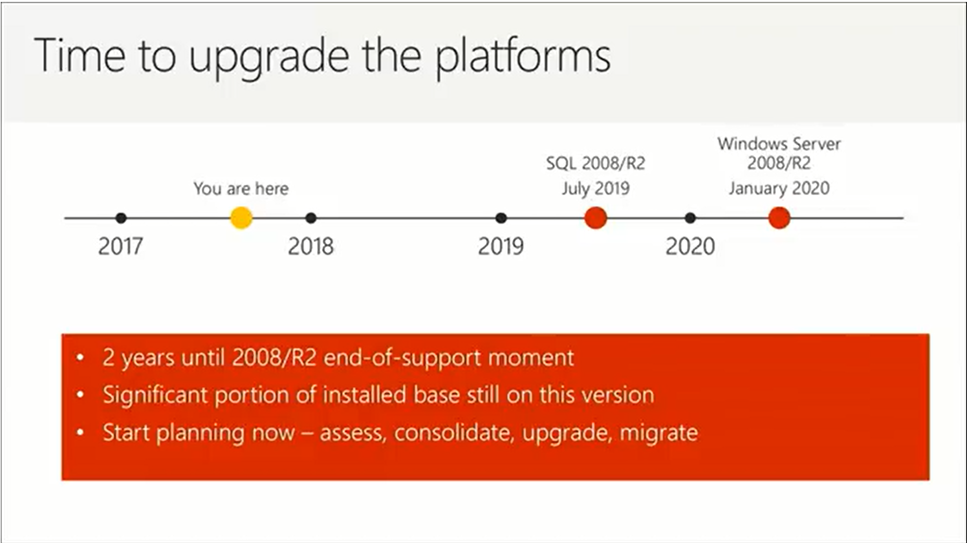 1:02:46 Microsoft and Docker Modernize Traditional Apps (MTA) Program
1:02:46 Microsoft and Docker Modernize Traditional Apps (MTA) Program
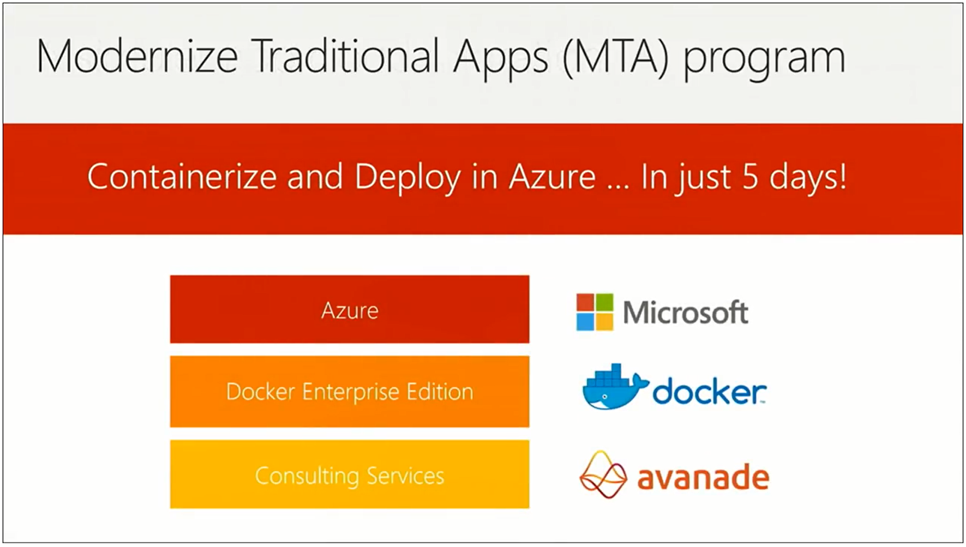
This is a joint venture with Docker and other companies to assist you with your modernization efforts. In a five-day event, Docker will help you containerize and migrate your apps, which can be moved to Azure or kept on-premises. This is a great opportunity to get assistance moving those pesky legacy apps to a modern infrastructure.
1:05:39 Windows Insider Program

Join the Insiders Program! This is the only way to see new releases and beta features. There won't be more Technical Previews released, only Insider Preview builds.
Q&A
1:08:41 – The demo showing docker commands, can you take any application and containerize it?
Not necessarily. The application must be GUI-less. The biggest push right now is old .NET and Java apps. Anything that has a remote GUI, remote management, there is no GUI in a container.
Second part of question – Will future Exchange servers be able to be put into a container?
We are already seeing it in SQL. There have been a few million downloads of SQL to containers already. That's just the SQL engine, not all of SQL's features make sense to go into a container. Can't speak broadly that everything will end up in a container, but Microsoft is looking through options. With so many companies moving to Office 365, does it make sense to try and containerize Exchange? The answer is still being looked at.
1:11:07 - Will Project Honolulu be backported to work with older server versions?
Project Honolulu (now Windows Admin Center) can manage back to Windows Server 2012 from the server management perspective. Since the WAC does more than just manage, not all features may be available.
1:11:43 - Project Honolulu is accessed through a browser, so where is the web server that is managing it?
The management client can be installed in different ways. It can be installed on a target server, run locally on a workstation, or it can be run off a server in the middle.
Follow up question – If the web server is located on a server other than one being managed, is it talking over legacy remoting protocols?
No, the WAC uses PowerShell and WMI.
1:13:00 – The premise of containers is that you can take an app that has been running on Windows 2003 happily for years, put it into a Windows 2003 container, and deploy the container on Windows 2016?
There are no 2003 containers, you would put it in container running Server 2016 Server Core.
Continuation - But then you have to test everything again, what's the big benefit, the application gets a new environment? Might as well just put it on a Server 2016 VM!
Working with customer running a .NET 3 app on Server 2003 R2, what are the benefits of moving to Server Core and putting it in a container on Server 2016? Many benefits:
- Now running on a supported OS
- Just by moving to 2016, upped the security with kernel protections, credential guard, remote credential guard, defender is built in, and performance will skyrocket too
- Also, now it has been moved into a more DevOps workflow
And continuing - But what's the benefit of doing that in Docker?
The container now doesn't have full OS, don't have to manage OS, self-contained, developer can use that as unit of deployment. Benefit probably more from developer perspective than IT, but still have big benefits.
There you have it, what's new and what's next for Windows Server! I hope this was beneficial to you! Leave me a comment or request for a particular session or technology you'd like to see covered, and I'll do my best to get it to you!
Here's the link to my first Ignite blog on Server clustering and storage in case you missed it.